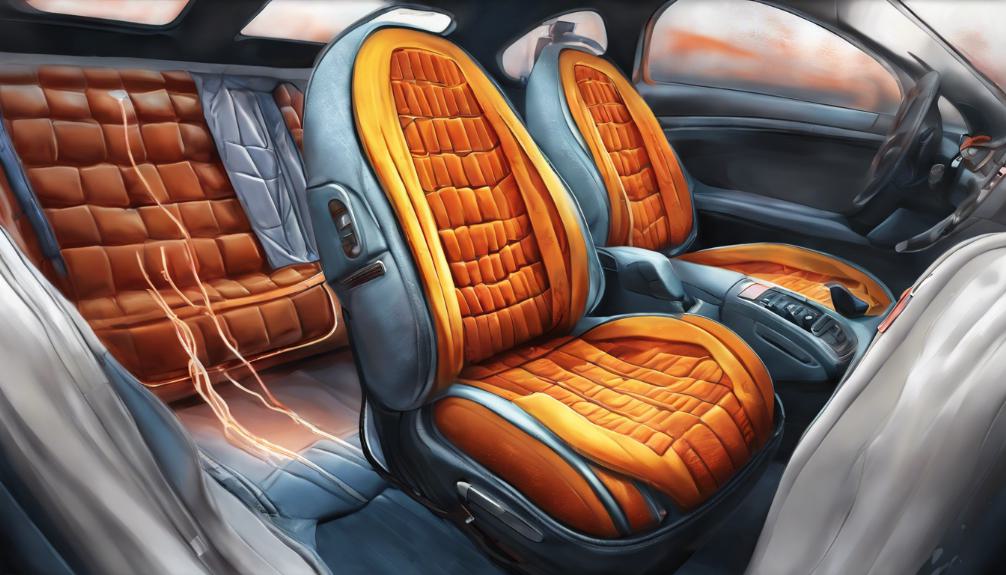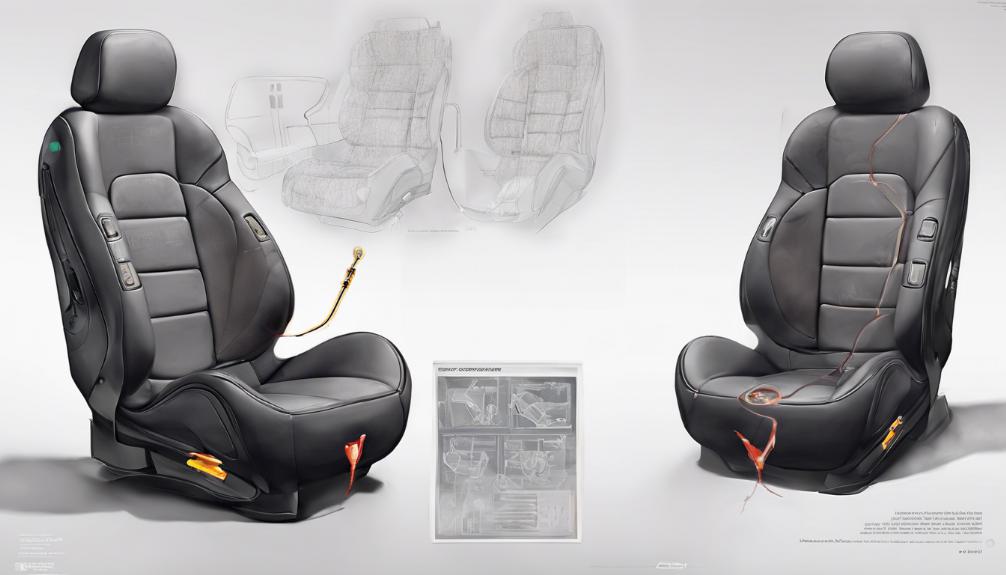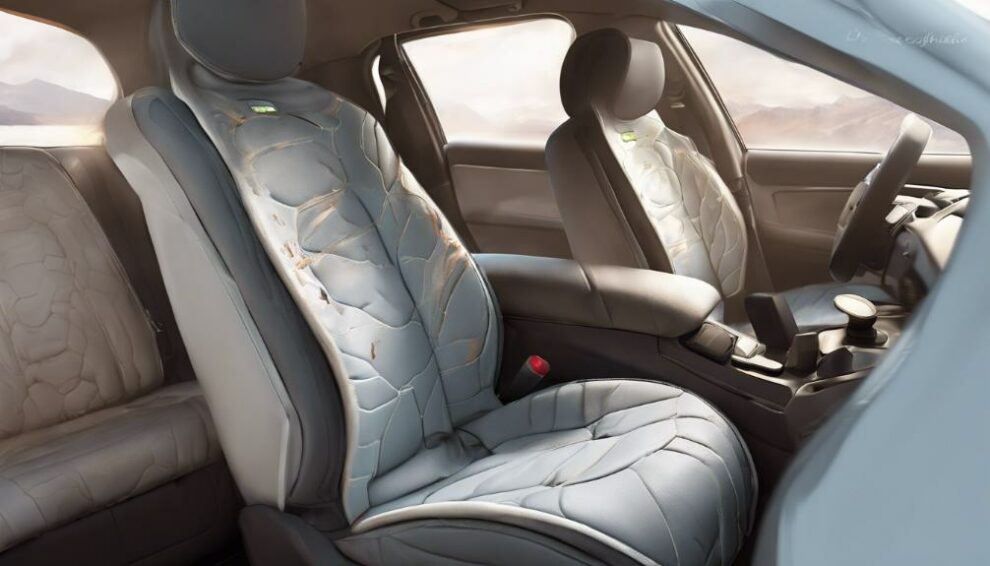To guarantee compatibility between heated seats and seat covers, opt for thin, breathable materials like polyester. Thick materials can block the heat transfer from the heating elements, affecting performance.
Confirm the seat covers don’t impede airbag deployment or seatbelt functionality for safety. Proper installation is critical for heat distribution efficiency; align covers over heating elements correctly.
Regularly clean the covers following manufacturer guidelines to prevent damage. By understanding these compatibility factors, you can enhance both functionality and safety of your heated seats and seat covers setup.
More insights await you regarding this topic.
Key Points
- Choose thin, breathable materials for optimal heat transfer.
- Ensure seat covers do not obstruct airbag deployment.
- Proper installation prevents damage and ensures efficient heating.
- Confirm compatibility with integrated side airbags.
- Regular cleaning and maintenance preserve seat covers and prevent damage.
Understanding Heated Seat Technology

Exploring how heated seat technology functions can enhance your understanding of the comfort and warmth they provide.
Heated car seats employ either carbon fibers or electrical coils as heating mechanisms to generate warmth.
These mechanisms distribute heat evenly across the seat, offering a cozy experience during chilly drives.
The benefits of warmth extend beyond mere comfort; heated seats can also provide relief by easing muscle tension, particularly beneficial in cold weather conditions.
Controls for these heated seats are conveniently located on the dashboard or center console for easy access, allowing you to adjust the temperature to your liking.
Understanding the heating mechanisms behind heated seats sheds light on why they’re such a popular feature in vehicles. The efficient generation of warmth not only enhances comfort but also promotes relaxation while driving.
Whether you’re facing a frosty morning commute or a cool evening drive, heated seats make sure you stay warm and cozy throughout your journey.
Choosing Compatible Seat Covers
When selecting seat covers for your vehicle with heated seats, opt for thin, breathable materials like polyester or CORDURA® to guarantee optimal heat transfer.
These materials allow the heat from your seat’s heating elements to pass through efficiently, ensuring that you experience the full benefits of your heated seats.
It’s important to avoid seat covers made of thick, foam-backed, or insulated materials as they can block the heat from reaching your body, reducing the effectiveness of the heated seats.
Choosing seat covers designed specifically for heated seats is vital for ensuring compatibility and efficient heat distribution.
These covers are tailored to work seamlessly with the heating elements in your seats, allowing the heat to be evenly dispersed across the seating surface.
Also, when selecting seat covers, consider aftermarket seat heaters if your vehicle doesn’t have built-in heated seats.
Ensure proper installation to maintain compatibility and optimize heat distribution for a comfortable driving experience.
Consult your vehicle manual or dealership for guidance on choosing seat covers that work effectively with heated seats.
Ensuring Safety Features Compatibility

To guarantee the safety of your vehicle’s occupants, it’s important to confirm that the chosen seat covers don’t obstruct the deployment of airbags.
Airbag compatibility is essential to make sure that in case of an accident, the airbags can deploy effectively and protect the passengers.
When selecting seat covers, make sure they’re designed to work with integrated side airbags if your vehicle is equipped with such safety features.
Also, check that the seat covers don’t impede the functionality of split folding seats, as this could affect the ease of access to the rear of the vehicle or the storage space.
Another crucial aspect to take into account for safety is maintaining seatbelt functionality.
Choose seat covers that don’t require modifications to the seatbelt system, ensuring that it functions correctly in restraining passengers during sudden stops or collisions.
Following fitting instructions provided by the manufacturer is important to guarantee proper airbag deployment and overall safety features compatibility.
By paying attention to these details, you can enhance the safety of your vehicle without compromising comfort or style.
Can Radiator Hose Issues Affect the Compatibility of Heated Seats and Seat Covers?
When experiencing 6 signs for radiator hose replacement, it’s crucial to address the issue promptly. Failing radiator hoses can cause overheating, which may affect the compatibility of heated seats and seat covers. It’s important to resolve radiator hose issues to ensure proper functioning of the vehicle’s heating system.
Installation Tips for Heated Seat Covers
Properly installing heated seat covers is essential to guarantee efficient heat transfer and maintain the functionality of your vehicle’s heating elements.
To ensure peak performance, make sure the seat covers don’t obstruct the heating elements or wires of the heated seats.
Following manufacturer guidelines for installation is vital as it can prevent damage to both the seat covers and the heated seats.
Proper positioning of the seat covers over the heating elements is key to maintaining the effectiveness of the heated seats.
Securely fastening the seat covers without wrinkles or folds helps maintain consistent heat distribution throughout the seat.
When installing heated seat covers, take care to align them correctly with the heating elements underneath. Avoid bunching up the covers or leaving any areas exposed, as this can lead to uneven heating.
Smooth out the covers and secure them tightly to ensure they stay in place and don’t interfere with the heat distribution.
By paying attention to proper positioning and securing the covers well, you can maintain the heat distribution and enjoy the benefits of your heated seats for a long time.
Maintenance and Cleaning Guidelines

Align your focus on maintaining the cleanliness and quality of your heated seat covers by following recommended maintenance and cleaning guidelines.
To keep your seat covers in top condition, start by regularly vacuuming to remove debris and dirt. For stains, use gentle spot cleaning techniques with a mild cleaner to preserve the fabric.
When it’s time for a deeper clean, refer to the manufacturer’s instructions for machine washing, ensuring you follow the recommended settings to avoid damaging the covers.
After washing, air-dry the seat covers thoroughly to prevent shrinkage or other potential harm.
Remember to always check the care labels on your seat covers for specific cleaning guidelines tailored to the fabric type.
By following these stain removal techniques and fabric care tips, you can extend the lifespan of your heated seat covers and keep them looking fresh and comfortable for a long time.
As an Amazon Associate we earn from qualifying purchases.










